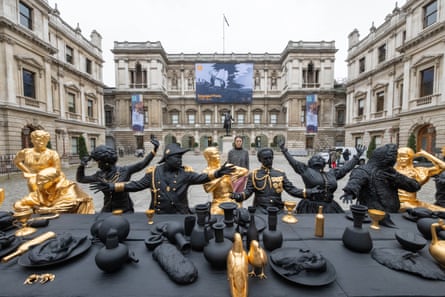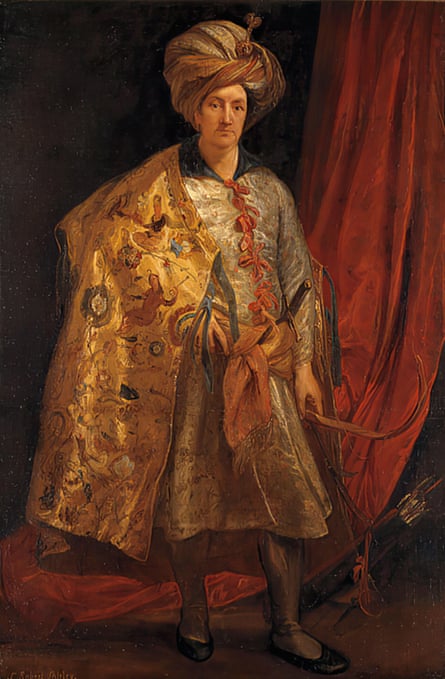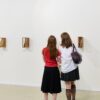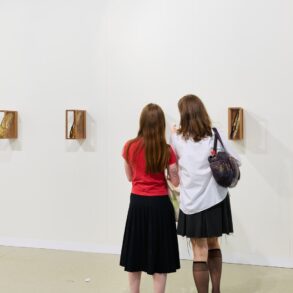Exhibition of the week
Beyond Form: Lines of Abstraction, 1950-1970
Abstract art by women including Eva Hesse and Marisa Merz, from the era between 1950 and 1970 when modernism triumphed, then broke into more organic and personal visions.
Turner Contemporary, Margate, from 3 February until 6 May
Also showing
Paolozzi at 100
A celebration of one of the first pop artists who progressed from small collages to sculptures in heavy metal. Was he a modern great or a bit clunking and pretentious?
Modern (Modern Two), Edinburgh, until 21 April
Entangled Pasts, 1768–now: Art, Colonialism and Change
The radical Georgian artist William Blake loathed the Royal Academy, which had then been recently founded, as an establishment club. Here it confesses its own sins, castigating itself for its connections with slavery. So Blake has the last laugh.
Royal Academy, London from 3 February until 28 April
John Russell: Foyer
An installation that involves angels, flies and a portal to hell in the gallery floor.
Arcadia Missa, London, until 17 February
Alexis Hunter
A survey of this feminist artist who died in 2014 leaving a striking body of radical art.
Richard Saltoun Gallery, London, from 6 February until 30 March
Image of the week

The Royal Academy introduces its new show Entangled Pasts in the gallery’s courtyard, with Tavares Strachan’s dominating sculpture The First Supper (Galaxy Black) inspired by Leonardo da Vinci’s The Last Supper. The life-size dinner guests are significant figures from black history, with Haile Selassie as the Christ-like figure surrounded by proxy apostles including Harriet Tubman, Marcus Garvey and Mary Seacole. Read our review.
What we learned
The V&A’s ‘return’ of looted Ghana gold is a new way to tackle Britain’s painful past
Bloomberg New Contemporaries in London is the perfect way to look at art
More architects are using their skills to improve the wellbeing of elderly people
Sculptor Gillian Lowndes was rude, punky and downright diabolical
The Mona Lisa was responsible for Henry VIII’s marriage to Catherine Seymour
The British Museum’s wildly enjoyable show Legion is a Rome for everyone
Barbara Kruger’s cacophonous work satirised Trumpspeak long before Maga
A new gallery is galvanising Madagascar’s neglected art scene
An Australian ‘contemporary’ portrait prize is allowing AI-generated entries
Masterpiece of the week
Sir Robert Shirley by Anthony van Dyck, 1622




An upper-class Englishman poses in “oriental” clothes for a spectacular portrait (pictured above) by the super-talented Van Dyck that hangs in one of Britain’s grandest stately homes. What’s going on here? Is this painting a cynical act of cultural appropriation, an arrogant imperial theft of others’ garb? The truth is more complex. Robert Shirley was ambassador to Abbas I of Persia, known as Abbas the Great, under whose rule Iranian culture reached brilliant heights. Shirley was besotted, and adopted the dress of his hosts. He and his wife, Teresia Shirley, who was Circassian, were in Rome, in their habitual finery, when Van Dyck met and painted them. He lavishes Titianesque, fantastical brushwork on Shirley’s robes while depicting his face with precise realism.
Petworth House, West Sussex
Don’t forget
To follow us on X (Twitter): @GdnArtandDesign.
Sign up to the Art Weekly newsletter
If you don’t already receive our regular roundup of art and design news via email, please sign up here.
Get in Touch
If you have any questions or comments about any of our newsletters please email newsletters@theguardian.com
This post was originally published on this site be sure to check out more of their content







